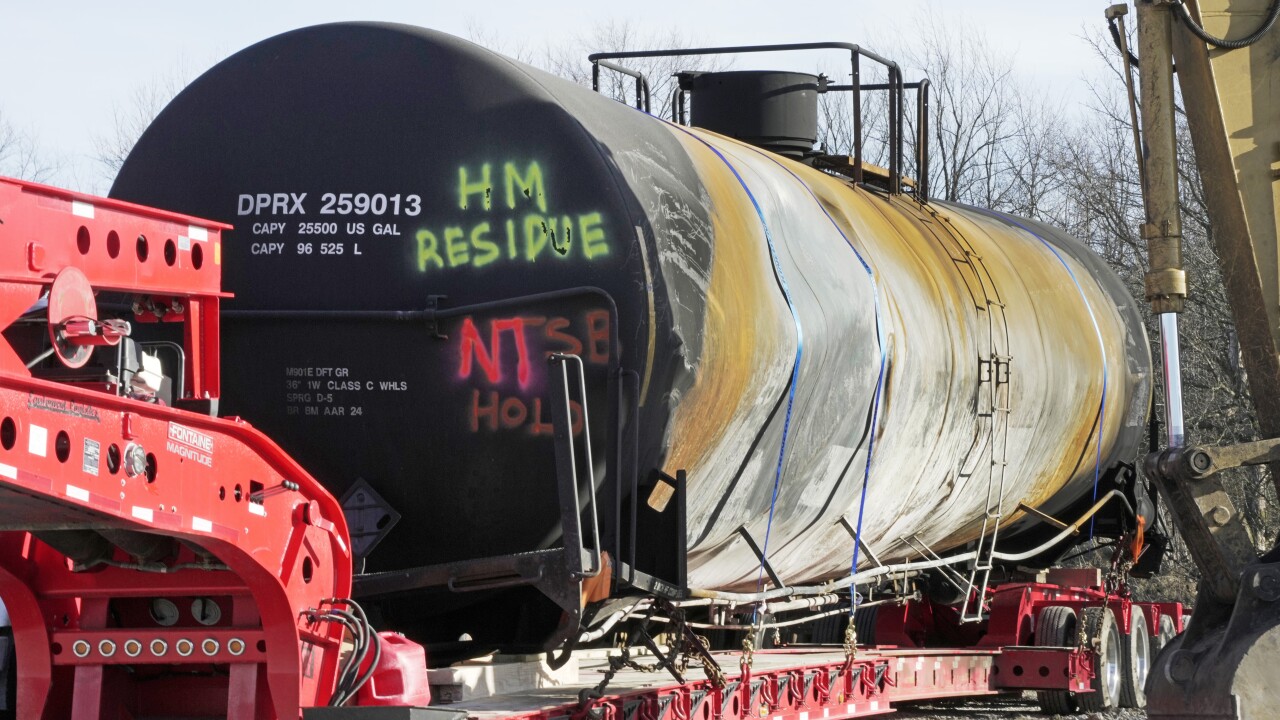Ohio Train Derailment: Investigation Into Persistent Toxic Chemical Contamination

Table of Contents
The Initial Disaster and Immediate Aftermath
On February 3, 2023, a Norfolk Southern freight train derailed in East Palestine, Ohio, unleashing a plume of toxic chemicals into the surrounding environment. The derailment involved approximately 50 cars, several carrying hazardous materials. The immediate aftermath saw a controlled release and burn of vinyl chloride, a known carcinogen, to prevent a potentially larger explosion. This decision, while made to mitigate immediate risks, raised further concerns about the long-term effects of the released chemicals.
- Date and location of the derailment: February 3, 2023, East Palestine, Ohio.
- List of major chemicals released: Vinyl chloride, butyl acrylate, ethylhexyl acrylate, and ethylene glycol monobutyl ether.
- Initial evacuation orders and emergency response measures: Mandatory evacuations were ordered for a one-mile radius around the derailment site. Emergency responders worked to contain the spill and prevent further chemical release.
- Immediate environmental impacts: Significant air and water contamination was reported immediately following the derailment. Concerns were raised about the contamination of local waterways and potential soil contamination.
- Initial reports of health issues among residents: Residents reported experiencing headaches, nausea, and respiratory issues following the derailment.
Ongoing Environmental Contamination
The release of hazardous chemicals from the Ohio train derailment has resulted in persistent contamination across multiple environmental media. The long-term impacts on the environment are still unfolding and require ongoing monitoring and remediation.
- Soil testing results and their implications: Soil samples collected from the affected area have shown elevated levels of various contaminants, indicating the need for extensive soil remediation. The long-term implications for soil health and potential impact on groundwater are significant concerns.
- Water contamination levels in local waterways and drinking water sources: Testing has revealed contamination in local waterways, raising concerns about the impact on aquatic life and the potential for drinking water contamination. The long-term effects on the local ecosystem are yet to be fully assessed.
- Air quality monitoring data and long-term health risks: While air quality has improved since the initial release, ongoing monitoring is crucial to assess the long-term health risks associated with residual contaminants. The potential for long-term respiratory and other health problems remains a major concern.
- The challenge of bioremediation and long-term cleanup efforts: Cleaning up the contaminated soil and water will be a lengthy and complex process. Bioremediation strategies are being considered, but the effectiveness and timeframe for complete remediation remain uncertain.
- Potential for groundwater contamination and its impact: The potential for groundwater contamination poses a significant long-term threat to the region's water supply and ecosystem. Extensive monitoring and remediation efforts are necessary to prevent long-term damage.
The Role of Vinyl Chloride
Vinyl chloride, a major chemical released in the derailment, is a known human carcinogen. Exposure to vinyl chloride can lead to a range of serious health problems, including liver cancer, brain cancer, and other cancers.
- Known health risks associated with vinyl chloride exposure: Cancer (liver, brain, lung), liver damage, circulatory system disorders, and neurological effects.
- Difficulty in detecting long-term effects of low-level exposure: The long-term effects of low-level vinyl chloride exposure are difficult to detect and may manifest years after exposure.
- The need for ongoing health monitoring of affected communities: Long-term health monitoring programs are crucial for detecting potential health problems linked to vinyl chloride exposure.
- The potential for delayed onset health problems: Many health problems associated with vinyl chloride exposure may not appear for many years after exposure, highlighting the importance of ongoing health surveillance.
Health Impacts on Residents and First Responders
Residents and first responders in East Palestine have reported a variety of health problems following the derailment. These health issues include respiratory problems, skin irritations, and headaches.
- Specific health complaints reported by residents and first responders: Respiratory problems (coughing, shortness of breath), headaches, nausea, skin rashes, eye irritation, and other symptoms.
- Challenges in establishing a direct causal link between exposure and health issues: Establishing a direct causal link between chemical exposure and reported health problems can be challenging, necessitating thorough epidemiological studies.
- The need for long-term health studies and monitoring programs: Long-term health studies are essential to fully assess the health impacts of the derailment and to develop appropriate interventions.
- The importance of providing medical support to affected communities: Continued access to medical care and support is critical for affected residents and first responders.
The Investigation and Regulatory Response
Several investigations are underway to determine the cause of the derailment and assess the adequacy of the response. The National Transportation Safety Board (NTSB) and the Environmental Protection Agency (EPA) are leading these investigations.
- Role of the NTSB and EPA in the investigation: The NTSB is investigating the cause of the derailment, while the EPA is overseeing the cleanup and environmental monitoring.
- Regulatory changes proposed or implemented in response to the incident: Calls for stricter regulations on the transportation of hazardous materials are increasing following the derailment.
- Accountability of Norfolk Southern and other relevant parties: Determining the accountability of Norfolk Southern and other parties involved is a key aspect of the ongoing investigation.
- The need for stricter regulations regarding hazardous materials transport: The incident highlights the need for improved safety measures and stricter regulations regarding the transportation of hazardous materials.
Long-Term Monitoring and Remediation Strategies
Long-term monitoring and comprehensive remediation plans are crucial to address the persistent Ohio train derailment toxic contamination.
- Strategies for cleaning up contaminated soil and water: Effective strategies for cleaning up contaminated soil and water are essential to mitigate long-term environmental risks.
- Methods for assessing and mitigating long-term environmental risks: Ongoing environmental monitoring is critical for assessing long-term risks and implementing effective mitigation strategies.
- The importance of community involvement in the remediation process: Involving the affected community in the remediation process is vital to ensure transparency and build trust.
- The need for transparency and public access to information: Open communication and public access to information about the cleanup efforts and health monitoring data are essential.
Conclusion
The Ohio train derailment toxic contamination represents a significant environmental and public health crisis with far-reaching consequences. The persistent nature of the contamination underscores the need for comprehensive and ongoing investigations, robust remediation efforts, and long-term health monitoring of affected communities. Addressing the long-term consequences requires a multi-faceted approach involving government agencies, regulatory bodies, and the affected communities themselves. Staying informed about the ongoing investigations and advocating for comprehensive remediation and health monitoring is crucial to ensuring the safety and well-being of those impacted by this devastating event. Continued vigilance and pressure for accountability are vital to preventing similar disasters and ensuring a safe and healthy future for the affected communities. Further research into the long-term effects of Ohio train derailment toxic contamination is critical.

Featured Posts
-
 Podcast Onetu I Newsweeka Stan Wyjatkowy Opinie I Analizy
May 18, 2025
Podcast Onetu I Newsweeka Stan Wyjatkowy Opinie I Analizy
May 18, 2025 -
 La Fire Aftermath Price Gouging Allegations Surface Selling Sunset Star Speaks Out
May 18, 2025
La Fire Aftermath Price Gouging Allegations Surface Selling Sunset Star Speaks Out
May 18, 2025 -
 Film Dokumenter No Other Land Oscar Dan Kisah Konflik Palestina Israel
May 18, 2025
Film Dokumenter No Other Land Oscar Dan Kisah Konflik Palestina Israel
May 18, 2025 -
 Confirmed Brooklyn Flea Remains At Dumbo Archway Plaza Until 2027
May 18, 2025
Confirmed Brooklyn Flea Remains At Dumbo Archway Plaza Until 2027
May 18, 2025 -
 Dove Cameron And Damiano David New Photos Surface Amid Tour Announcement
May 18, 2025
Dove Cameron And Damiano David New Photos Surface Amid Tour Announcement
May 18, 2025
